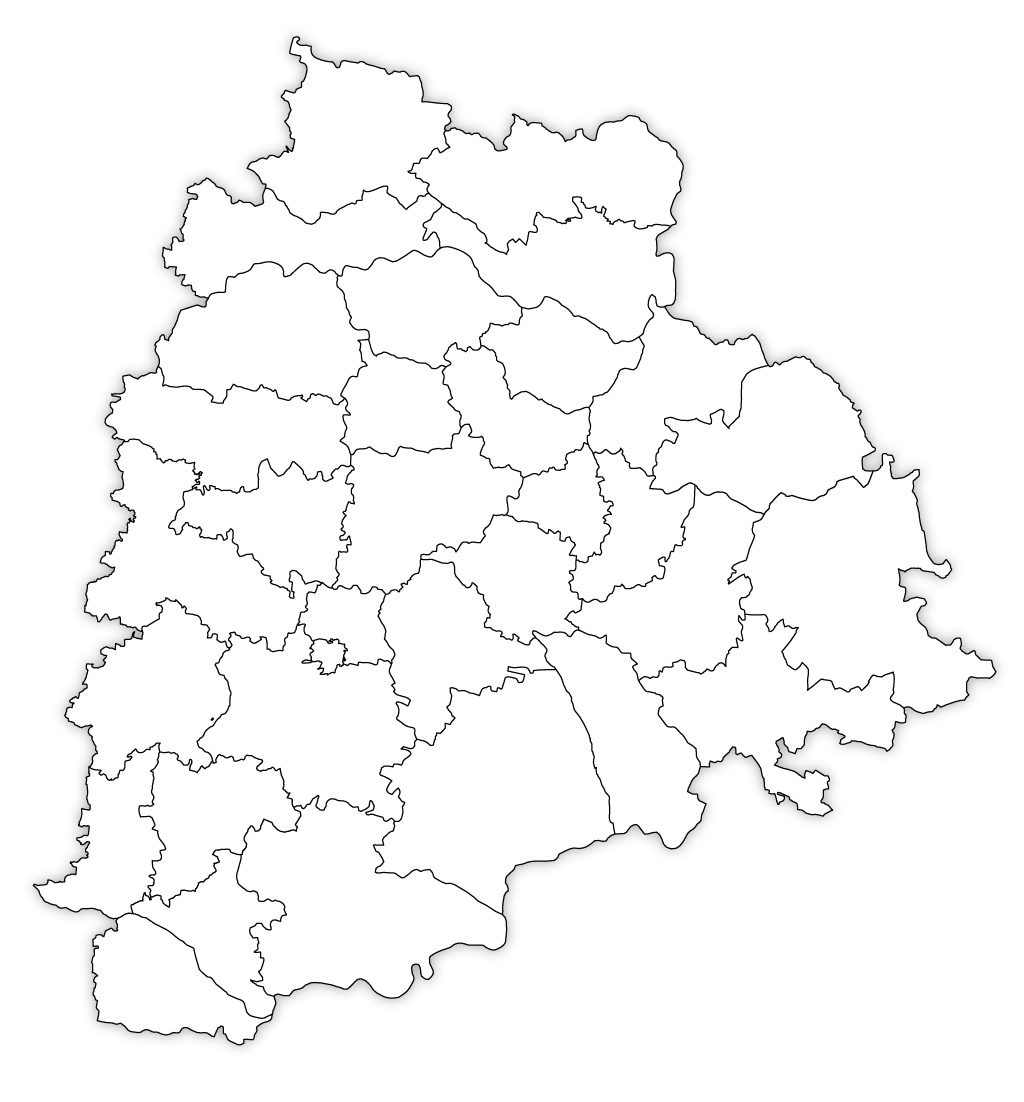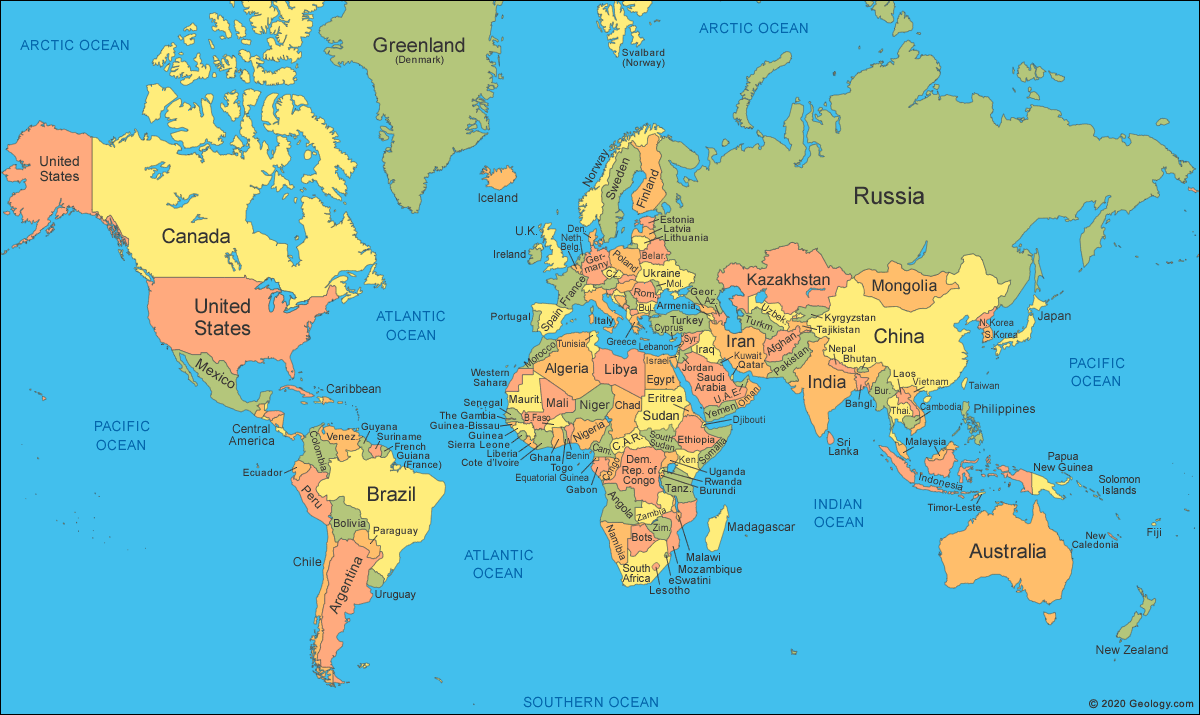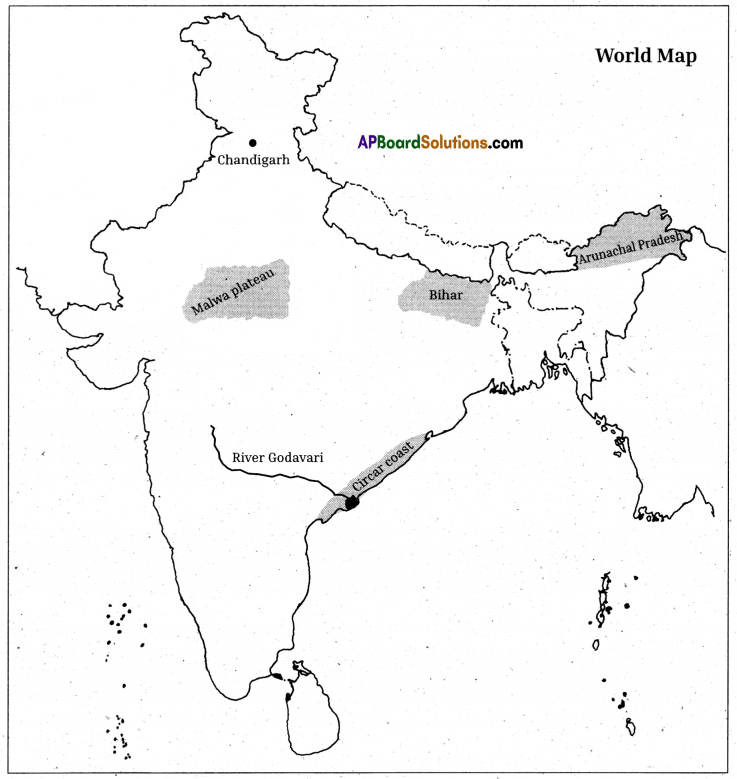2023 – Social Studies
MARKS : 80
SECTION – I
Each question carries 2 marks.
1. What are the factors that affect the density of population in India?
The density of population in India is influenced by several factors:
- Geographical Factors:
- Fertile plains (e.g., Indo-Gangetic Plains) support higher population density due to agricultural productivity.
- Harsh terrains like mountains and deserts (e.g., Himalayas, Thar Desert) have sparse populations.
- Climate:
- Moderate climates attract more people (e.g., coastal regions), while extreme climates (e.g., Rajasthan, Ladakh) deter settlement.
- Economic Factors:
- Industrial and commercial hubs (e.g., Mumbai, Bengaluru) have high population density due to employment opportunities.
- Social and Cultural Factors:
- Regions with rich cultural heritage and urban infrastructure attract populations (e.g., Delhi, Kolkata).
- Infrastructure:
- Areas with better transportation, healthcare, and educational facilities support higher populations.
2. What are the objectives of the National Food Security Act?
The objectives of the National Food Security Act (NFSA), 2013 are:
- To ensure food and nutritional security for the population by providing access to affordable and sufficient food grains.
- To provide subsidized food grains to eligible households under the Public Distribution System (PDS).
- To focus on the special needs of vulnerable groups such as pregnant women, lactating mothers, and children.
- To promote the right to food as a legal entitlement for the economically weaker sections of society.
3. Which quality of Dr. B.R. Ambedkar do you like the most? Give reasons.
One of the most admirable qualities of Dr. B.R. Ambedkar is his commitment to social equality and justice.
- Reason: Dr. Ambedkar dedicated his life to eradicating caste-based discrimination and worked for the upliftment of marginalized communities.
- He fought for the rights of Dalits and women and emphasized the importance of education as a tool for empowerment.
- His role in drafting the Indian Constitution ensured that India became a democratic and secular nation where everyone is treated equally under the law.
4. What are the consequences of frequent violation of the election code of conduct by political parties at present?
- Erosion of Democratic Values:
- Violations undermine the fairness and integrity of elections, weakening democracy.
- Unethical Campaign Practices:
- Use of hate speech, false promises, and personal attacks create mistrust among voters.
- Misuse of Government Resources:
- Misusing public resources like funds and infrastructure for political campaigns disrupts transparency.
- Rise in Political Corruption:
- Violations like bribing voters lead to increased corruption and compromise on the quality of leadership.
- Legal and Social Consequences:
- Frequent violations lead to legal disputes, delays in election results, and public disillusionment with political institutions.
5. Draw the outline map of Telangana.
To draw the outline map of Telangana,

6. Observe the following table and answer the questions A & B.
A. What does the above table show?
The table shows the distribution of workers in India across various sectors based on the following parameters:
- Place of Residence: Rural and Urban areas.
- Sex: Male, Female, and All Workers.
- Sectors: Agriculture, Industry, and Services.
Key Observations:
- A large percentage of rural workers (59.8%) are engaged in agriculture, whereas urban areas have a significant share in the services sector (59.1%).
- Female workers are predominantly employed in the agriculture sector (57.2%), while males have a relatively higher share in the services (32.8%) and industry (26.4%) sectors.
B. Why has the share of employment in the agriculture sector not decreased?
- Dependence on Agriculture:
- A large section of the rural population relies on agriculture as their primary source of livelihood.
- Lack of alternative employment opportunities in rural areas contributes to this dependence.
- Low Industrial and Service Sector Penetration in Rural Areas:
- Industries and services are concentrated mainly in urban areas, limiting rural diversification.
- Small Landholdings and Subsistence Farming:
- Many rural households practice subsistence farming to meet their basic needs, keeping them tied to agriculture.
- Slow Economic Transition:
- India’s economy is transitioning from agriculture to industry and services, but the pace has been gradual, leaving a significant workforce in agriculture.
- Government Support:
- Subsidies, loan waivers, and support schemes for agriculture encourage people to stay in the sector rather than move to other industries.
SECTION-II
Each question carries 4 marks.
7. What are the basic concepts that contribute to an area becoming a settlement? Explain them.
Settlements develop due to several basic concepts, which include:
- Availability of Water:
- Proximity to rivers, lakes, or other water sources supports agriculture, drinking water needs, and domestic usage.
- Fertile Land:
- Fertile soil encourages agricultural activities, leading to permanent settlements.
- Natural Resources:
- The availability of resources like forests, minerals, and fish influences the establishment of settlements.
- Transport and Connectivity:
- Easy access to transportation routes like roads, railways, or waterways promotes trade and interaction, leading to settlements.
- Security:
- Areas offering natural protection (e.g., hills or forests) attract people for safety against invasions or natural disasters.
- Economic Opportunities:
- Regions offering employment in industries, services, or trade often become hubs for settlements.
8. What changes occurred in Indian democracy between 1975-1985?
- Emergency Period (1975-1977):
- Fundamental rights were suspended during the Emergency declared by Indira Gandhi.
- The judiciary and press faced restrictions, and political opposition was suppressed.
- Restoration of Democracy (1977):
- The Janata Party came to power, marking the first non-Congress government at the center.
- Constitutional Amendments:
- Key amendments, such as the 44th Amendment, were introduced to prevent misuse of Emergency powers.
- Growth of Regional Parties:
- Regional parties gained prominence, leading to coalition politics.
- Economic Policies:
- Measures like the Green Revolution strengthened agriculture, while nationalization of banks continued.
- Public Awareness:
- Citizens became more aware of their rights, leading to greater participation in the democratic process.
9. Prepare a pamphlet explaining the need for organic farming.
Title: Embrace Organic Farming for a Healthier Future
What is Organic Farming?
Organic farming avoids synthetic fertilizers and pesticides, focusing on sustainable and eco-friendly agricultural practices.
Why Choose Organic Farming?
- Health Benefits: Produces chemical-free and nutrient-rich food.
- Environmental Protection: Prevents soil and water pollution caused by harmful chemicals.
- Biodiversity Conservation: Encourages the use of natural pest control and crop rotation.
- Soil Fertility: Enhances soil health using compost, manure, and bio-fertilizers.
- Sustainability: Reduces dependency on non-renewable resources.
Take Action Today!
Switch to organic farming for a sustainable future. Support farmers and choose organic products for your family’s well-being.
10. Read the given paragraph and interpret it.
Paragraph:
Most small farmers have to borrow money to arrange for the working capital. They borrow from large farmers or the village moneylenders or the traders who supply various inputs for cultivation. The rate of interest on such loans is very high.
Interpretation:
The paragraph highlights the challenges faced by small farmers:
- Dependence on Credit: Small farmers lack adequate savings and depend on external sources for working capital.
- High-Interest Rates: Loans from informal sources like moneylenders and traders often have exorbitant interest rates, increasing the financial burden.
- Cycle of Debt: Due to low agricultural income and high loan repayment costs, small farmers often fall into a cycle of debt.
- Need for Institutional Support: The situation underscores the importance of providing small farmers with access to affordable credit through banks or cooperatives.
- Policy Intervention: Government initiatives like subsidies and interest-free loans can alleviate their struggles and promote agricultural growth.
11. Locate the following on the outline map of the World:
- Washington, USA: Located in the northwestern part of the United States.
- Japan: An island nation in East Asia, located in the Pacific Ocean near the eastern coast of China and Korea.
- Congo: Located in central Africa, specifically the Democratic Republic of Congo in the equatorial region.
- Italy: A European country shaped like a boot, located in southern Europe, surrounded by the Mediterranean Sea.

12. Observe the given table and analyze it:
Net Irrigated Area in Lakh Hectares
| Region | 1955-56 | 2006-07 | Growth% |
|---|---|---|---|
| Andhra Region | 17 | 23 | 135% |
| Telangana Region | 7 | 19 | 257% |
Analysis:
- Overall Growth:
- Both regions showed significant growth in net irrigated area over the period.
- Telangana region’s irrigation growth percentage (257%) is notably higher than Andhra region’s growth percentage (135%).
- Improved Irrigation Infrastructure:
- Increased growth in Telangana could be attributed to the development of irrigation projects like reservoirs and canals.
- Regional Focus:
- Focused efforts in Telangana to enhance agricultural productivity contributed to higher growth.
- Key Observations:
- While Andhra region still has a larger irrigated area, the gap between the two regions has reduced significantly by 2006-07.
SECTION – III
Each question carries 6 marks
13. Classify the Himalayas and explain.
The Himalayas are classified into three main ranges based on their altitude, location, and geological features:
- The Greater Himalayas (Himadri):
- The highest range with peaks like Mount Everest and Kanchenjunga.
- Known for its perpetual snow and glaciers.
- Contains important passes like Nathu La and Shipki La.
- The Lesser Himalayas (Himachal):
- Lies south of the Greater Himalayas.
- Includes prominent hill stations like Shimla, Mussoorie, and Darjeeling.
- Rich in forests and moderate snowfall.
- The Shivalik Range:
- The outermost and the lowest range.
- Composed of unconsolidated sediments brought by rivers.
- Known for its fertile foothills and Terai region.
14. Explain the relations between India and China.
India and China share a complex relationship marked by cooperation and competition:
- Historical Ties:
- Ancient cultural and trade exchanges along the Silk Road.
- Shared Buddhist heritage.
- Border Disputes:
- Ongoing tensions over the Line of Actual Control (LAC).
- Notable conflicts include the 1962 war and recent clashes in Galwan Valley (2020).
- Trade Relations:
- China is one of India’s largest trading partners.
- However, trade imbalance is a significant issue.
- Global Cooperation:
- Collaboration in multilateral forums like BRICS and the Shanghai Cooperation Organisation (SCO).
- Challenges:
- Issues over China’s Belt and Road Initiative and its growing influence in South Asia.
15. Why are the working conditions of workers in the unorganized sector not improving even today? Suggest suitable measures.
Reasons for Poor Working Conditions:
- Lack of Regulation: Absence of strict labor laws for unorganized sectors.
- Low Wages: Workers are paid below minimum wages.
- Job Insecurity: No formal contracts lead to vulnerability.
- Health Hazards: Unsafe work environments and lack of health benefits.
- Exploitation: Lack of awareness makes workers prone to exploitation by employers.
Suggested Measures:
- Enforce Labor Laws: Strengthen laws to ensure fair wages and working hours.
- Social Security: Provide benefits like health insurance and pensions.
- Skill Development: Organize training programs for better job opportunities.
- Union Formation: Encourage unions for collective bargaining.
- Government Support: Launch schemes for financial and social support to unorganized workers.
16. Read the following paragraph and write your opinion:
Paragraph:
“Land reforms were however implemented in a half-hearted manner across India. While the Zamindari system was abolished, redistribution of land to the landless did not take place. The rich and powerful in the rural areas continued to control most of the land.”
Opinion:
The paragraph highlights the incomplete implementation of land reforms in India. While abolishing the Zamindari system was a progressive step, the lack of proper redistribution failed to address inequality in land ownership.
- Issues in Implementation:
- Loopholes in laws allowed landlords to retain large portions of land.
- Bureaucratic inefficiencies and political pressure hindered reforms.
- Impact on Society:
- Continued dominance of the rich led to economic disparity.
- Marginalized communities remained landless and dependent on landlords.
Suggestions:
- Strict Monitoring: Ensure proper implementation of land ceiling laws.
- Transparent Redistribution: Distribute surplus land to the landless.
- Empowerment Programs: Provide financial and technical support to new landowners.
17. Locate the following on the outline map of India:
- Malwa Plateau
- Located in central India, mainly in Madhya Pradesh.
- Known for its rich cultural heritage and agricultural activities.
- River Godavari
- Originates from the Western Ghats in Maharashtra.
- Flows eastwards across Maharashtra, Telangana, and Andhra Pradesh, eventually emptying into the Bay of Bengal.
- Circar Coast
- Lies on the eastern coast of India, along the Andhra Pradesh coast, near the Bay of Bengal.
- Known for its sandy beaches and historical significance in trade.
- The State with the Lowest Density of Population
- Arunachal Pradesh has the lowest population density among Indian states, located in the northeastern region.
- Chandigarh
- A Union Territory and capital of Haryana and Punjab.
- Located in the northern part of India, known for its modern architecture and urban planning.
- Bihar
- A state in eastern India, known for its historical importance, including sites like Bodh Gaya.

18. Observe the given bar graph and analyze it:
The Armaments Race (1880-1914)
The bar graph represents the military expenditure by the great powers (Germany, Austria-Hungary, Great Britain, Russia, Italy, and France) from 1880 to 1914.
Key Analysis:
- Steady Increase in Military Expenditure:
- The bar graph shows a steady increase in military expenditure by the great powers leading up to 1914.
- A sharp rise is noticeable after 1900, indicating growing tensions in Europe.
- Germany’s Military Spending:
- Germany’s expenditure rises significantly from 1890 onwards, reflecting its military buildup in the prelude to World War I.
- Competition Among Powers:
- The graph highlights an arms race among major European powers. Each nation increased its military spending as a sign of competition, which contributed to the outbreak of World War I.
- Pre-War Context:
- The armaments race was one of the key factors leading to militarization and alliances, escalating tensions among European countries.
Conclusion:
The sharp rise in military expenditure, especially in the decade before 1914, reflects the growing instability in Europe, which played a role in triggering the First World War.
